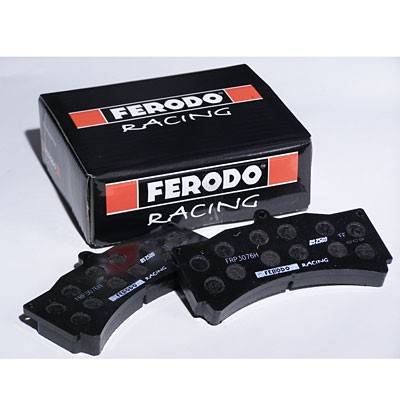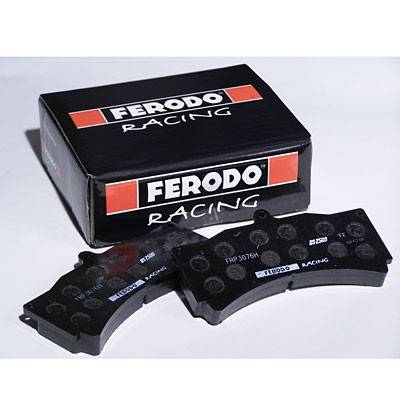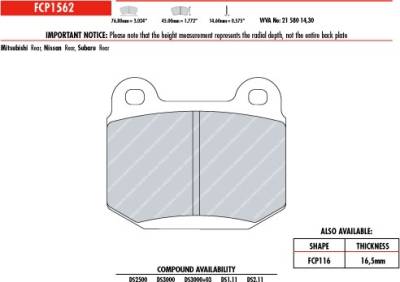Ferodo FCP1562C Mitsubishi Evolution Rear
FCP1562C
Ferodo’s 4003 was specifically developed for lighter cars (Formula 3, Formula Ford, Formula Opel, Formula Vauxhall, Formula Renault, Formula Campus) and Rally use. 4003 is the most commonly used pad worldwide in F3 championships. 4003 can also be used in the rear axle of front traction racing cars (off road, asphalt, track).
Pricing:
$276.41
Description
The main characteristics of 4003 are:
High coefficient of friction (0.48) at all speeds and temperatures
Short bedding-in time
Excellent initial bite
Predictability and reliability
Low drag/good release 4003 can also be used in the rear axle of front-wheel-drive racing cars (off-road, asphalt, track).
All part numbers in the range feature a suffix. This suffix identifies the material compound available for each part number. Many part numbers are available in more than one material and are therefore listed accordingly on our website with different suffixes as explained below:
H = DS2500
C = 4003
R = DS3000
M = DS3000 Plus 03
E = DS3000 Endurance
W = DS1.11
X = DS2.11
Technical Specifications
Manufacturer Part # FCP1562C
FMSI # D0961, D0109
Composition Semi-metallic
Category Endurance
Max Operating Temp 1400*F
Dust High
Noise Moderate
Bite/Mu High
Judder/Vibration Low
Pad Wear Moderate to Low
Rotor Wear Moderate
FMSI # D0961, D0109
Composition Semi-metallic
Category Endurance
Max Operating Temp 1400*F
Dust High
Noise Moderate
Bite/Mu High
Judder/Vibration Low
Pad Wear Moderate to Low
Rotor Wear Moderate
Bedding & Installation
Please follow your vehicle service manual for installation instructions, or have the work performed by a qualified technician.
Ferodo's recommended bedding procedure:
During manufacturing, all Ferodo racing products are subject to “chemical bedding” to stabilize the materials and resins used in construction of the pad. Although this “prebedding” is an effective method and sufficient for low temperature use, the ultimate results are achieved by actual bedding on either the car or dyno...
How ? ...
This subjects the pad to the correct heat and torque loads seen in race conditions. These methods transfer pad material into the face of the rotor leaving a “transfer film” the friction generated between the pad face and this transfer film determines the performance of the “bite”. Correct bedding also ensures that materials which may become compressible are stabilized with the heat and pressure to avoid a “spongy pedal”.
Why? ...
When bedding in the car always try to bed on used rotors. If bedding on new rotors follow the rotor bedding instructions of the manufacturer, as it is important to heat cycle them first before bedding the pads. After fitting the new pads prepare the car by blocking off 50 percent of the brake cooling / air ducts to speed the “heat up time”. When leaving the pit lane apply brake gently at low speed to ensure pads are fitted correctly, build up temperature progressively to approx 350° C (670° F). This enables the heat to distribute around all areas of the pad.
When brakes are at suitable temperature begin bedding process, achieve approximately 70 percent of race speed then perform 25-30 brake applications at half normal race pedal pressure holding on for 4 seconds. When this is completed use a slowing down lap to allow brakes to cool. Return to the pit lane and allow pads to cool completely, check rotor appearance. Transfer film should be constant around rotor face, any “patchy” deposit will result in brake pedal judder. The use of temperature paint on rotors enables more accurate bedding procedures.
Ferodo's recommended bedding procedure:
During manufacturing, all Ferodo racing products are subject to “chemical bedding” to stabilize the materials and resins used in construction of the pad. Although this “prebedding” is an effective method and sufficient for low temperature use, the ultimate results are achieved by actual bedding on either the car or dyno...
How ? ...
This subjects the pad to the correct heat and torque loads seen in race conditions. These methods transfer pad material into the face of the rotor leaving a “transfer film” the friction generated between the pad face and this transfer film determines the performance of the “bite”. Correct bedding also ensures that materials which may become compressible are stabilized with the heat and pressure to avoid a “spongy pedal”.
Why? ...
When bedding in the car always try to bed on used rotors. If bedding on new rotors follow the rotor bedding instructions of the manufacturer, as it is important to heat cycle them first before bedding the pads. After fitting the new pads prepare the car by blocking off 50 percent of the brake cooling / air ducts to speed the “heat up time”. When leaving the pit lane apply brake gently at low speed to ensure pads are fitted correctly, build up temperature progressively to approx 350° C (670° F). This enables the heat to distribute around all areas of the pad.
When brakes are at suitable temperature begin bedding process, achieve approximately 70 percent of race speed then perform 25-30 brake applications at half normal race pedal pressure holding on for 4 seconds. When this is completed use a slowing down lap to allow brakes to cool. Return to the pit lane and allow pads to cool completely, check rotor appearance. Transfer film should be constant around rotor face, any “patchy” deposit will result in brake pedal judder. The use of temperature paint on rotors enables more accurate bedding procedures.
Details
- FCP1562C
- FCP1562C
- Ferodo
- New
Shipping Information
- Item Requires Shipping
- 6.5 lbs.
- W4.0000” x H3.0000” x L6.5000”
Customer Reviews
 Total Reviews (0)
Total Reviews (0)
You must login to post a review.







Write the First Review!